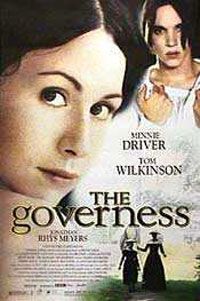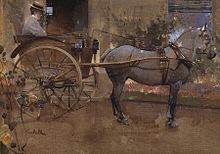A governess is a girl, lady, or woman employed to teach and train children in a private household.
The position is rarer now, except within large and wealthy households such as those of the Saudi royal family and in remote regions such as outback Australia. It was common in well-off European families before World War I, especially in the countryside where no suitable school existed nearby. Parents' preference to educate their children at homeâ€"rather than send them away to boarding school for months at a timeâ€"varied across time and countries. Governesses were usually in charge of girls and younger boys. When a boy was old enough, he left his governess for a tutor or a school.
There has been a recent resurgence amongst families worldwide to employ governesses or full-time tutors. This has been for a number of reasons including personal security, the benefits of a tailored education, and the flexibility to travel or live in multiple locations.
§Role

Traditionally, governesses taught "The three Rs" to young children. They also taught the "accomplishments" expected of middle class women to the young ladies under their care, such as French or another language, the piano or another musical instrument, and often painting (usually the more ladylike watercolors rather than oils) or poetry. It was also possible for other teachers (usually male) with specialist knowledge and skills to be brought in, such as, a drawing master or dancing master.
The governess occupied a uniquely awkward position in the Victorian household, because she was neither a servant nor yet a member of the host family. A governess had a middle-class background and education, yet was paid for her services. As a sign of this social limbo she frequently ate on her own, away from the rest of the family and servants. By definition, a governess was an unmarried woman who lived in someone else's home, which meant that she was subject to their rules. In any case, she had to comply with prevailing Victorian social standards which were rigid and unforgiving i.e. maintain an impeccable reputation by avoiding anything which could embarrass or offend her employers. If a particular governess was young and attractive, the lady of the house might well perceive a potential threat to her marriage, and enforce the governess' social exclusion more rigorously. As a result of these various restrictions, the lifestyle of the typical Victorian governess was often one of social isolation and solitude, without the opportunity to make friends. The fact that her presence in the household was underpinned by an employment contract emphasized that she could never truly be part of the host family. However, being a governess was one of the few legitimate ways by which an unmarried middle class woman could support herself in Victorian society. Not surprisingly, her position was often depicted as one to be pitied, and the only way out of it was to get married. Unfortunately, it was difficult for a governess to find a suitable husband because most of the eligible men she encountered were her social superiors, who preferred a bride from within their own social class, particularly since such women generally had better financial resources. Once a governesses' charges grew up, she had to seek a new position, or, exceptionally, might be retained by the grown-up daughter as a paid companion.
§In fiction

Several well-known works of fiction, particularly in the nineteenth century, have focused on governesses.
- Becky Sharp, the main character in William Makepeace Thackeray's novel Vanity Fair, is employed as a governess.
- Violet Hunter, in "The Adventure of the Copper Beeches", a Sherlock Holmes story.
- Violet Smith, in "The Adventure of the Solitary Cyclist", a Sherlock Holmes story.
- Henry James's most famous governess is the over-sensitive and perhaps hysterical protagonist in The Turn of the Screw.
- Stiva, the brother of the eponymous heroine in Anna Karenina, had an affair with his children's governess.
- Vera Claythorne in Agatha Christie's And Then There Were None. She was Cyril Hamilton's governess.
- Jane Austen's novel Emma opens with the eponymous heroine losing Miss Taylor, the governess who had become a family companion, to marriage with Mr. Weston. Later, Jane Fairfax feels the threat of being forced to become a governess if her covert attachment to Frank Churchill all comes to nothing.
- Maria, the main character in The Sound of Music, leaves convent life to become a governess, and later marries her employer Georg von Trapp
- Terry Pratchett's Discworld novel Hogfather features a governess named Susan Sto Helit.
- Soap opera Dark Shadows featured the character Victoria Winters as the governess to David Collins.
- Libba Bray's Ann in The Sweet Far Thing briefly to her cousins
- Jane Eyre, the eponymous protagonist in Charlotte Brontë's novel Jane Eyre, serves as a governess to the ward of her future husband, Edward Fairfax Rochester.
- Dante serves as governess to Stephen Dedalus and his siblings in James Joyce's A Portrait of the Artist as a Young Man.
- Hester, a character in Diane Setterfield's novel The Thirteenth Tale, is a governess at the Angelfield estate.
- Arabella Minton a governess in Eva Ibbotson's novel Journey to the River Sea.
- Agnes in Anne Brontë's novel Agnes Grey, different from her sisters' novels, Agnes Grey portrays a more realistic view of what life for a governess was like in Victorian England.
- Sugar, for a time, in Michel Faber's novel The Crimson Petal and the White.
- Miss Penelope Lumley, the main character in Incorriglbie Children of Ashton Place
- Mary Poppins, the governess of Jane and Michael in "Mary Poppins"
- Mary Morstan, the wife of Dr. John Watson in the Sherlock Holmes book series.
§In film
- The Governess is a 1998 British period drama film written and directed by Sandra Goldbacher.
- Maggie Evans/Victoria Winters is hired to be governess to David Collins in the 2012 film Dark Shadows.
- Maria Von Trapp, governess to the Von Trapp children in "The Sound of Music"
§In TV
- Kathryn Janeway in the 1995 Star Trek: Voyager episode "Cathexis" during her holo-novel. Subsequently seen again in "Learning Curve"
- Clara Oswin Oswald in the 2012 Doctor Who Christmas special The Snowmen
§Notable governesses

- Katherine Swynford, who was governess to the children of John of Gaunt, and later became his mistress, the mother of his Beaufort children, and his duchess. She was a great-great grandmother of Henry VII of England through his mother Lady Margaret Beaufort.
- Margaret Pole, Countess of Salisbury, governess to Princess Mary, later Queen Mary I of England. They were also distant cousins.
- Katherine Ashley, governess to Queen Elizabeth I of England.
- Madame de Maintenon, who became the last mistress of Louis XIV of France, gained entry to his inner circle as governess to his illegitimate offspring, the children of Madame de Montespan.
- Baroness Louise Lehzen and Charlotte Percy, Duchess of Northumberland, Queen Victoria's governesses.
- Anne Sullivan, the so-called Miracle Worker, who educated the remarkable deaf and blind girl Helen Keller.
- Anna Leonowens, governess in what is now Thailand, whose memoir Anna and the King of Siam inspired the musical drama The King and I
- Marion Crawford ("Crawfie"), governess of Queen Elizabeth II and Princess Margaret.
- Marie Curie, worked as a governess in multiple households to fund her education, later became one of the most influential women in the history of science.
§Other uses

The term "governess" also refers to a female politician who serves as governor, although it is now considered archaic, and has been replaced by "governor".
§See also

- Agatha Christie's classic mystery And Then There Were None
- English Nanny & Governess School
- Home schooling
§References

§Further reading
- Broughton, Trev and Ruth Symes: The Governess: An Anthology. Stroud: Sutton, 1997. ISBN 0-7509-1503-X
- Budde, Gunilla: Als Erzieherinnen in Europa unterwegs: Gouvernanten, governesses und gouvernantes, EGO â€" European History Online, Mainz: Institute of European History, 2011, retrieved: 21 February 2013.
- Hughes, Kathryn: The Victorian Governess, London: Hambledon, 1993. ISBN 1-85285-002-7
- Peterson, M. Jeanne: "The Victorian Governess: Status Incongruence in Family and Society", in Suffer and Be Still: Women In the Victorian Age, ed. Martha Vicinus. Bloomington: Indiana University Press, 1972.
§External links

- Britishtutors.com, British Tutors - Tuition agency providing governesses worldwide
- The Victorian Governess, a bibliography, at Victorian Web
- VAM.ac.uk, Richard Redgrave's 'The Governess' discussed at the V&A Museum.
